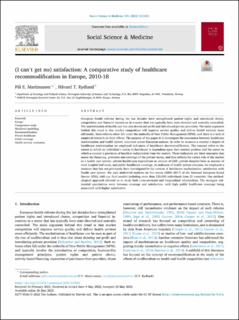| dc.contributor.author | Martinussen, Pål Erling | |
| dc.contributor.author | Rydland, Håvard Thorsen | |
| dc.date.accessioned | 2022-10-06T06:41:56Z | |
| dc.date.available | 2022-10-06T06:41:56Z | |
| dc.date.created | 2022-06-21T12:46:54Z | |
| dc.date.issued | 2022 | |
| dc.identifier.citation | Social Science and Medicine. 2022, 305 . | en_US |
| dc.identifier.issn | 0277-9536 | |
| dc.identifier.uri | https://hdl.handle.net/11250/3024166 | |
| dc.description.abstract | European health reforms during the last decades have strengthened patient rights and introduced choice, competition and financial incentives in a sector that has typically been state-directed and centrally controlled. The marketisation of health care has also drawn out profit and introduced private provision. The main argument behind this trend is that market competition will improve service quality and deliver health services more efficiently. Such reforms often fall under the umbrella of New Public Management (NPM), and there is a lack of empirical research on their effects. The purpose of this paper is to investigate the association between healthcare marketisation and health system outcomes across European nations. In order to measure a country's degree of healthcare marketisation we employed indicators of healthcare decommodification. The concept refers to the extent to which an individual's access to healthcare is dependent upon their market position and the extent to which a country's provision of health is independent from the market. These indicators are three measures that assess the financing, provision and coverage of the private sector, and thus reflects the varied role of the market in a health care system: private health care expenditure as amount of GDP, private hospital beds as amount of total hospital bed stock, and public healthcare coverage. As indicator of health system outcome, we employed a measure that has not previously been investigated in the context of healthcare marketisation: satisfaction with health care system. We used multilevel analyses on five waves (2009–2017) of the biannual European Social Survey (ESS), with our final models including more than 120,000 individuals from 21 countries. Our methodological approach allowed us to study both cross-sectional and longitudinal relationships. The strongest substantial associations were between coverage and satisfaction, with high public healthcare coverage being associated with higher satisfaction. | en_US |
| dc.language.iso | eng | en_US |
| dc.rights | Navngivelse 4.0 Internasjonal | * |
| dc.rights.uri | http://creativecommons.org/licenses/by/4.0/deed.no | * |
| dc.title | (I can't get no) satisfaction: A comparative study of healthcare recommodification in Europe, 2010-18 | en_US |
| dc.title.alternative | (I can't get no) satisfaction: A comparative study of healthcare recommodification in Europe, 2010-18 | en_US |
| dc.type | Peer reviewed | en_US |
| dc.type | Journal article | en_US |
| dc.rights.holder | © 2022 The Authors | en_US |
| dc.description.version | publishedVersion | en_US |
| cristin.ispublished | true | |
| cristin.fulltext | original | |
| cristin.qualitycode | 2 | |
| dc.identifier.doi | 10.1016/j.socscimed.2022.115083 | |
| dc.identifier.cristin | 2033824 | |
| dc.source.journal | Social Science and Medicine | en_US |
| dc.source.volume | 305 | en_US |
| dc.source.pagenumber | 11 | en_US |

